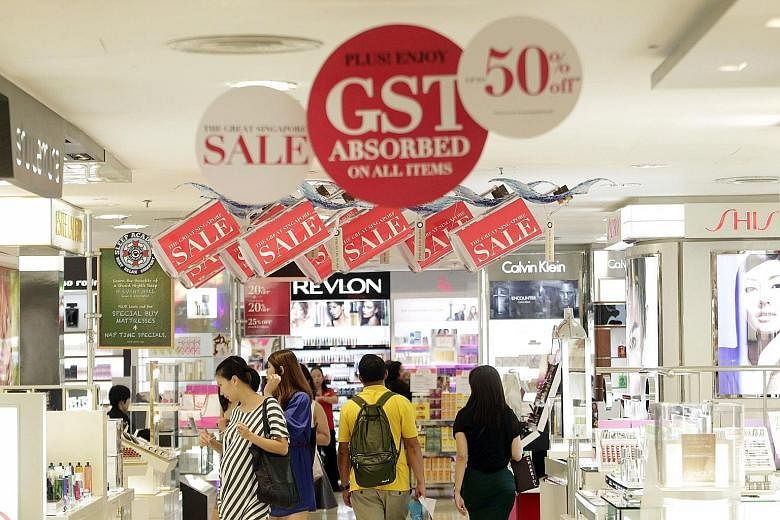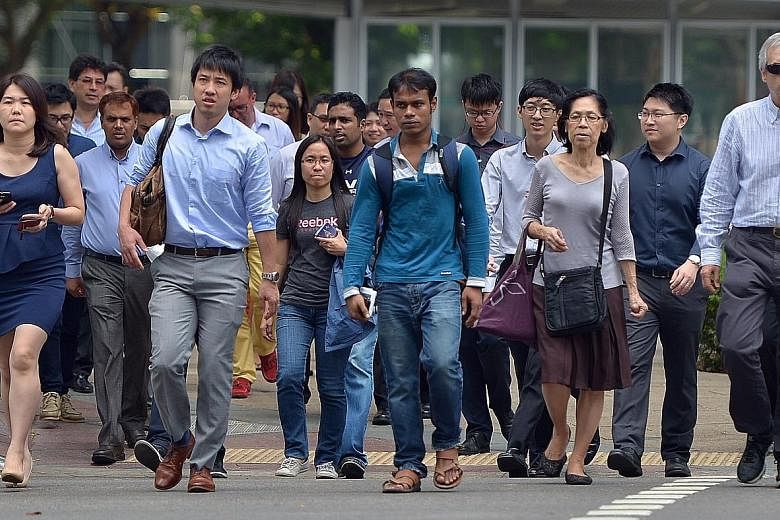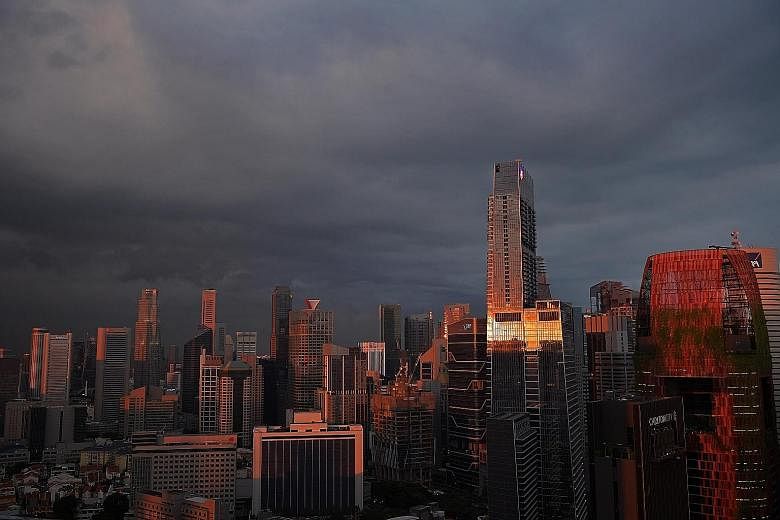"It's a lethal thing to suddenly raise taxes."
Doing so would be "political suicide", cautioned Nobel Prize-winning economist Robert Mundell in the run-up to the 2008 United States presidential election. Governments and politicians across the world that do not heed the warning have found themselves burnt. Taxes are one of the hottest potatoes in politics.
Similarly, in Singapore, the issue can easily ignite - and the Government has moved quickly to dampen the heat. For instance, when stickers with the slogan "Say No to 10 per cent GST - vote wisely" were distributed one month before the 2015 General Election, the Finance Ministry briskly came out to say there was no basis to claims that it would raise the GST after the polls.
Now, while Prime Minister Lee Hsien Loong has said that the Government has enough revenue for this term, he has also made it clear that with infrastructure and social spending set to grow, it was not a question of whether taxes would be raised - but when.
"There's never a single right time (to raise taxes) but occasionally, they are necessary," said Senior Minister of State for Finance Indranee Rajah in an interview with Insight. When doing so, she said, people and businesses must have enough time to adjust to the changes, while the lower income and vulnerable have to be "sufficiently buffered".
Signalling its intentions early - sometimes two years in advance - is a key part of the Government's tax hike toolbox. Others include offset packages and staggered increases.
Insight looks at major tax changes in Singapore over the years, and the political price - if any - they have exacted on the ruling People's Action Party.
Goods and services tax
INTRODUCED WHEN?
1994, at 3 per cent
REASONS
• Will boost Singapore's competitiveness by allowing for cuts in individual and corporate income taxes.
• Prepares for an ageing population, while avoiding excessive tax burden on working population.
PREPARING THE GROUND
It took about eight years.
The idea of a general consumption tax came up as early as in the 1986 Report of the Economic Committee, urging that groundwork should begin. MPs cried foul.
Finance Minister Richard Hu told Singaporeans then, and in subsequent Budget speeches, that the Government was still studying the tax, which would be implemented only when necessary.
The nation learnt about GST on Feb 9, 1993, when the GST White Paper was released - about 14 months before it was to kick in on April 1, 1994. At a press conference releasing the White Paper, Dr Hu promised that it would be capped at 3 per cent for at least five years.
The Government sweetened the deal with an offset package of cuts in personal and corporate income taxes, and higher personal reliefs and rebates for taxpayers.
Help was also given to low-income households, and the combination of income tax cuts and rebates, said Dr Hu at the 1993 Budget, would be enough to fully offset GST for nearly all households earning at least $1,500 a month.
In 1995, the offset package came to $1.8 billion, higher than the $1.6 billion of GST collected.
REACTION
A booming economy and the generous offset measures helped to cool anger over the move.
"We capitalised on the sweetness of a booming economy to introduce a very bitter pill," recalled tax academic Stephen Phua of the National University of Singapore. Nominal GDP growth hit 13 per cent in 1993 and 14 per cent in 1994.
This was partly why it was tolerated despite being "one of the worst things for a government to justify in front of its voters", he said.
It also helped that the GST rate was low, at 3 per cent. The Government, not needing the revenue collected then, was able to return it to the people with handouts.
"Rate cuts, reliefs and rebates resulted in more than two-thirds of taxpayers falling outside the income tax net," said Prof Phua.
POLITICAL PRICE
In the GE that followed - three years later, in 1997 - GST came under fire from opposition parties. Mr Chiam See Tong of the Singapore People's Party asked if it would be raised, and Mr J. B. Jeyaretnam of the Workers' Party called it an example of how the PAP government made decisions without consulting the people.
But the issue did not appear to seize the electorate enough. Instead, the PAP's dangling of estate and property upgrading and other carrots for the electorate helped propel its vote share to 65 per cent, from 61 per cent in 1991.
GST hike round 1
In May 2002, Mr Lee Hsien Loong, who was then Finance Minister, announced that GST was to rise to 5 per cent with from January 2003. There was an outcry by consumers and businesses hit by the economic downturn. In response, Mr Lee said in December the hike would be phased in over two stages: to 4 per cent in January 2003, and to 5 per cent in January 2004.
This time, Economic Restructuring Shares were given out. The package came up to $4 billion in total, going to areas such as HDB rental for low-income households, as well as service and conservancy rebates.
REACTION
Singapore Management University accounting professor Sum Yee Loong said that although the Government increased GST in two stages to make the changes gradual, it became "cumbersome for trading" and spread unhappiness over a longer time among Singaporeans.
It upset retailers which had little chance to recover from the 2001 recession before being hit by the spread of the severe acute respiratory syndrome, though most still said they would absorb the GST rise. In 2003, the Singapore Retailers Association tried unsuccessfully to convince the Government to postpone the next hike.
POLITICAL PRICE
The PAP's vote share dropped to 66.6 per cent at the 2006 election, from 75.3 per cent in 2001.
That year, opposition candidates criticised the Government for not keeping the cost of living low, pointing out that GST and carpark fees rose after the last election in 2001.
But a post-election survey by the Institute of Policy Studies found that the cost of living, the job situation and upgrading were not the issues of primary concern, possibly due to strong economic and job growth. Instead, top concerns included the need for an efficient government and fairness of policy.
GST hike round 2
The increase to 7 per cent was announced in November 2006, after the election. It took effect in July 2007. It came with a $4 billion offset package of GST credits, with the poor getting the largest share, as well as senior citizens' bonuses and other assistance. Prime Minister Lee Hsien Loong this time drew an explicit link between the hike and the need to spend more to help the poor. GST vouchers were made permanent in 2012.
REACTION
In 2007, there appeared to be a quieter response than before, with fewer consumers and businesses expressing unhappiness .
POLITICAL PRICE
PAP's vote share slid to 60.1 per cent at the 2011 polls, and the party lost-for the first time - a GRC.
During the campaign, opposition parties accused the PAP of jacking up GST after the 2006 election, warning of further hikes.
But the most hotly debated issues during the campaign were HDB policies, an overburdened public transport system and the liberal immigration policy. These bolstered the desire among many for a check on the ruling party.
Personal income tax
INTRODUCED WHEN?
1948, with the top rate at 30 per cent. Since then, it has gone down over the years to 20 per cent - with just one increase since independence: It was increased to 22 per cent this year.
PREPARING THE GROUND
The hike was announced in Budget 2015 and kicked in two years later, for taxes paid this year.
This higher personal income tax rate for the top 5 per cent of earners is expected to bring in about $400 million more revenue a year. Then finance minister Tharman Shanmugaratnam stressed that Singapore's philosophy was to keep the burden on the middle-income low.
REACTION
While there have been no reports of a backlash, National University of Singapore's Professor Stephen Phua cautioned that there may be "resistance" from top earners eventually if such hikes continue.
Already, the top 11.5 per cent of taxpayers bear about 80 per cent of personal income tax revenue, he noted.
In Hong Kong, about two in five workers pay salaries tax, with 60 per cent of revenue from the top 5 per cent of earners. For those who pay income tax, the rate is a progressive 2 to 17 per cent.
Other analysts have said that while tax rates are important, they are not the main factor in where people choose to live.
Corporate income tax
INTRODUCED WHEN?
1948, at 40 per cent.
REASON
An urgent need for money to balance the Budget, and to introduce a steady and equitable form of taxation for future revenue.
REACTION
When the Income Tax Bill was first introduced in 1947, some objected, saying that such a tax was not necessary to balance the 1948 Budget. Singapore Advisory Council members were critical of the expenditure and astounded at trading losses. They felt that such an important change should await the decision of the Legislative Council, which would come into being in 1948.
While they were not against the tax itself, taxpayers were reportedly unhappy with the relentless manner that tax collectors "forced the issue". Some said they could not afford to pay the tax, which was seen as sprung upon them, and there were calls to postpone imposition.
Since 1987, the PAP Government has been slashing the rate till it reached 17 per cent in 2010. A low corporate income tax rate is seen as key to keeping Singapore competitive.
Today, the rate is among the world's lowest, at just 0.5 points higher than that of Hong Kong.
Many firms pay lower rates due to the partial tax exemption regime introduced in 2002.




